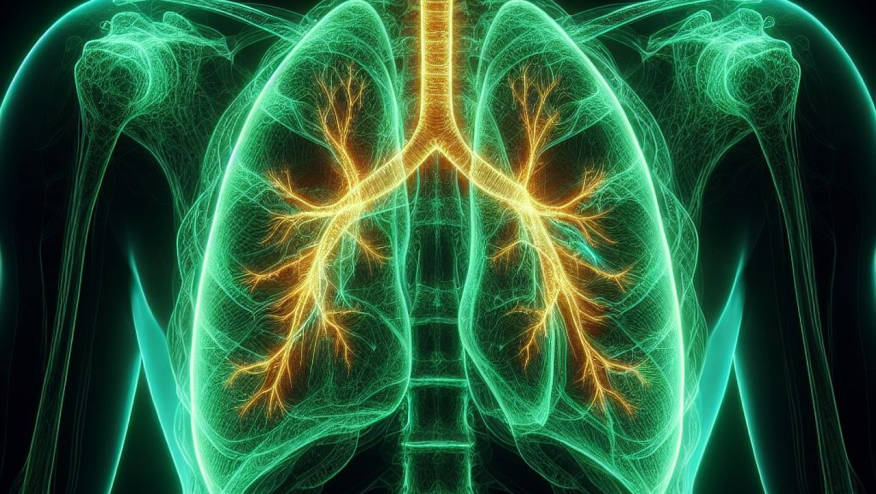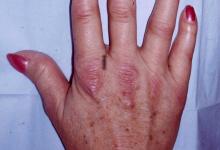When Myositis Hits the Lungs: What Every Rheumatologist Should Know About ILD Save

When idiopathic inflammatory myopathies (IIM) affect the lungs, the consequences can be serious. Interstitial lung disease (ILD) is not only common in IIM, but also one of the leading causes of death, contributing to up to 80% of mortality in this patient group (1). For rheumatologists, two subsets stand out: anti-synthetase syndrome (ASyS) and anti-MDA-5 positive dermatomyositis (MDA5-DM). These patients present with distinct clinical clues, very different disease trajectories, and unique treatment challenges. Recognizing ILD early and acting decisively can make the difference between stabilizing a chronic course and facing a rapidly progressive, often fatal decline (1,2).
Diagnosis: Clinical Suspicion and Key Tools
ILD may be the first or even sole manifestation of ASyS, preceding muscle or joint involvement. Clinical suspicion should be heightened in patients with unexplained dyspnea, persistent dry cough, or systemic signs such as mechanic’s hands, Raynaud’s phenomenon, or unexplained fever (3). In MDA5-DM, amyopathic or minimally symptomatic muscle disease accompanied by skin ulcerations or palmar papules should prompt immediate pulmonary evaluation(4).
Serological testing is central to diagnosis. Anti-Jo-1 and other anti-synthetase antibodies (PL-7, PL-12, OJ, EJ, KS, Zo, YRS, etc.) strongly support ASyS-ILD, while anti-MDA5 antibodies identify patients at high risk for rapidly progressive ILD (RP-ILD)(5). Coexistent anti-Ro52 antibodies have been associated with more severe ILD in both conditions (6).
High-resolution computed tomography (HRCT) remains the diagnostic gold standard. In ASyS, nonspecific interstitial pneumonia (NSIP) and organizing pneumonia (OP) are most frequent(3), whereas in MDA5-DM, OP often predominates and may evolve into diffuse alveolar damage, leading to a fulminant course (7). Pulmonary function tests (PFTs), particularly forced vital capacity (FVC) and diffusing capacity for carbon monoxide (DLCO), provide essential baseline assessment and are critical for longitudinal monitoring(1). DLCO is often the earliest parameter to decline, and serial testing every 2-3 months facilitates early detection of progression. Among functional measures, a reduction in FVC is a well-validated predictor of mortality in ILD (8–10).
Disease Course and Prognosis
Prognosis diverges between these entities (2). ASyS-ILD often follows a chronic, sometimes indolent, but usually progressive course. Ten-year survival approaches 75%, yet many patients require lifelong immunosuppression (11,12). Prognosis varies by antibody profile: anti-Jo-1 is associated with more favorable outcomes, whereas non-Jo-1 (especially anti-PL7, PL12) are associated with diagnostic delay due to lack of reliable antibody testing and often predict more severe, lung-dominant disease (13).
MDA5-DM, by contrast, frequently develops RP-ILD, with reported six-month mortality rates ranging from 33% to 66% (4). Adverse prognostic indicators include advanced age, reduced baseline pulmonary function, and elevated inflammatory markers such as C-reactive protein or serum ferritin (14)
Therapeutics: Tailored and Aggressive When Needed:
Corticosteroids remain the backbone of therapy. However, steroid-sparing agents are essential to achieve disease control and reduce toxicity (1,15).
In ASyS-ILD, first-line treatment commonly combines corticosteroids with either mycophenolate mofetil or azathioprine. Calcineurin inhibitors such as tacrolimus or cyclosporine, as well as rituximab, are frequently employed in cases of inadequate response or refractory disease (3). In MDA5-DM ILD, by contrast, early and intensive immunosuppression is crucial. Patients with RP-ILD are often treated with upfront triple therapy, consisting of high-dose corticosteroids, calcineurin inhibitor, and either cyclophosphamide or rituximab (4). Emerging data also suggest a role for Janus kinase inhibitors, particularly tofacitinib, in the management of RP-ILD (16).
For patients with progressive fibrosing ILD, antifibrotic therapy (e.g., nintedanib) may be added to slow functional decline (17). Supportive measures, including infection prophylaxis and pulmonary rehabilitation, remain integral. In cases of refractory or end-stage disease, timely referral to transplant-capable centers is vital, as lung transplantation can be lifesaving (1,18).
Conclusion
Effective management of ILD in ASyS and MDA5-DM requires vigilance, systematic evaluation, and timely intervention. Antibody testing, HRCT, and serial pulmonary function monitoring form the backbone of diagnosis and risk stratification. Prognosis differs substantially between the two conditions, with ASyS-ILD typically chronic progressive but manageable, and MDA5-DM ILD often rapidly fatal without aggressive treatment.
A multidisciplinary approach between rheumatology and pulmonology can optimize diagnosis and treatment decisions. The landscape continues to evolve with emerging targeted therapies, refined prognostic biomarkers, and improved understanding of IIM-ILD pathophysiology. Maintaining a low threshold for suspicion and intervening early with tailored immunosuppression remain the most effective strategies to improve patient outcomes.
References:
1. Saketkoo LA, Ascherman DP, Cottin V, Christopher-Stine L, Danoff SK, Oddis CV. Interstitial Lung Disease in Idiopathic Inflammatory Myopathy. Curr Rheumatol Rev. 2010 May;6(2):108–19.
2. Liu CH, Kor CT, Hung MH, Hsiao KH, Cheng YH, Tien YC. Differences in the Clinical Characteristics and 1-Year Mortality Rates of Patients with Dermatomyositis with anti-Jo-1 and anti-MDA5 Antibodies. J Immunol Res. 2023 Jan 4;2023:2988422.
3. Ghanbar MI, Danoff SK. Review of Pulmonary Manifestations in Antisynthetase Syndrome. Semin Respir Crit Care Med. 2024 Jun;45(3):365–85.
4. Wu W, Guo L, Fu Y, Wang K, Zhang D, Xu W, et al. Interstitial Lung Disease in Anti-MDA5 Positive Dermatomyositis. Clinic Rev Allerg Immunol. 2021 Apr 1;60(2):293–304.
5. Chaudhry S, Christopher-Stine L. Myositis interstitial lung disease and autoantibodies. Front Med (Lausanne). 2023 Jun 13;10:1117071.
6. Nayebirad S, Mohamadi A, Yousefi-Koma H, Javadi M, Farahmand K, Atef-Yekta R, et al. Association of anti-Ro52 autoantibody with interstitial lung disease in autoimmune diseases: a systematic review and meta-analysis. BMJ Open Respir Res. 2023 Nov 29;10(1):e002076.
7. Chen X, Jiang W, Jin Q, Peng Q, Zhang L, Lin S, et al. Clinical, radiological and pathological features of anti-MDA5 antibody-associated interstitial lung disease. RMD Open. 2023 May 31;9(2):e003150.
8. Shappley CL, Paik JJ, Saketkoo LA. Myositis-Related Interstitial Lung Diseases: Diagnostic Features, Treatment, and Complications. Curr Treat Options in Rheum. 2019 Mar 1;5(1):56–83.
9. Sehgal S, Patel A, Chatterjee S, Fernandez AP, Farver C, Yadav R, et al. Idiopathic inflammatory myopathies related lung disease in adults. Lancet Respir Med. 2024 Nov 29;S2213-2600(24)00267-4.
10. Pugashetti JV, Adegunsoye A, Wu Z, Lee CT, Srikrishnan A, Ghodrati S, et al. Validation of Proposed Criteria for Progressive Pulmonary Fibrosis. Am J Respir Crit Care Med. 2023 Jan 1;207(1):69–76.
11. Yamaguchi K, Sullivan DI, Khushboo S, Saygin D, Laverde SM, Moghadam-Kia S, et al. Long-term clinical prognosis of anti-aminoacyl-tRNA synthetase antibodies and interstitial lung disease. Clin Rheumatol. 2025 Aug;44(8):3341–52.
12. Nakanishi T, Ueyama M, Terada S, Hamao N, Inao T, Kaji Y, et al. Long-term outcome of 53 patients with anti-Jo-1 antibody-positive interstitial lung disease. European Respiratory Journal [Internet]. 2017 Dec 6 [cited 2025 Aug 25];50(suppl 61). Available from: https://publications.ersnet.org/content/erj/50/suppl_61/PA1515
13. Aggarwal R, Cassidy E, Fertig N, Koontz DC, Lucas M, Ascherman DP, et al. Patients with non-Jo-1 anti-tRNA-synthetase autoantibodies have worse survival than Jo-1 positive patients. Ann Rheum Dis. 2014 Jan;73(1):227–32.
14. Xie H, Zhang D, Wang Y, Shi Y, Yuan Y, Wang L, et al. Risk factors for mortality in patients with anti-MDA5 antibody-positive dermatomyositis: A meta-analysis and systematic review. Seminars in Arthritis and Rheumatism. 2023 Oct 1;62:152231.
15. Mehta P, Aggarwal R, Porter JC, Gunawardena H. Management of interstitial lung disease (ILD) in myositis syndromes: A practical guide for clinicians. Best Practice & Research Clinical Rheumatology. 2022 Jun 1;36(2):101769.
16. Chen Z, Wang X, Ye S. Tofacitinib in Amyopathic Dermatomyositis–Associated Interstitial Lung Disease. New England Journal of Medicine. 2019 Jul 18;381(3):291–3.
17. Flaherty KR, Wells AU, Cottin V, Devaraj A, Walsh SLF, Inoue Y, et al. Nintedanib in Progressive Fibrosing Interstitial Lung Diseases. New England Journal of Medicine. 2019 Oct 31;381(18):1718–27.
18. Rivière A, Picard C, Berastegui C, Mora VM, Bunel V, Godinas L, et al. Lung transplantation for interstitial lung disease in idiopathic inflammatory myositis: A cohort study. Am J Transplant. 2022 Dec;22(12):2990–3001.










If you are a health practitioner, you may Login/Register to comment.
Due to the nature of these comment forums, only health practitioners are allowed to comment at this time.